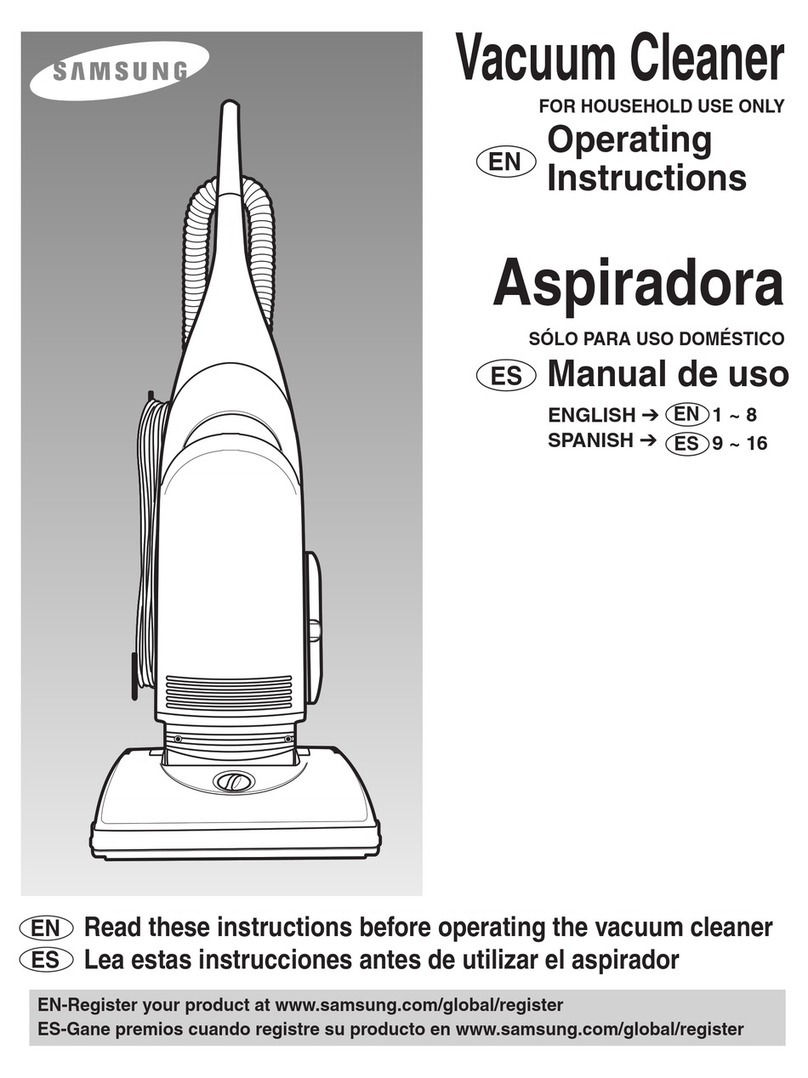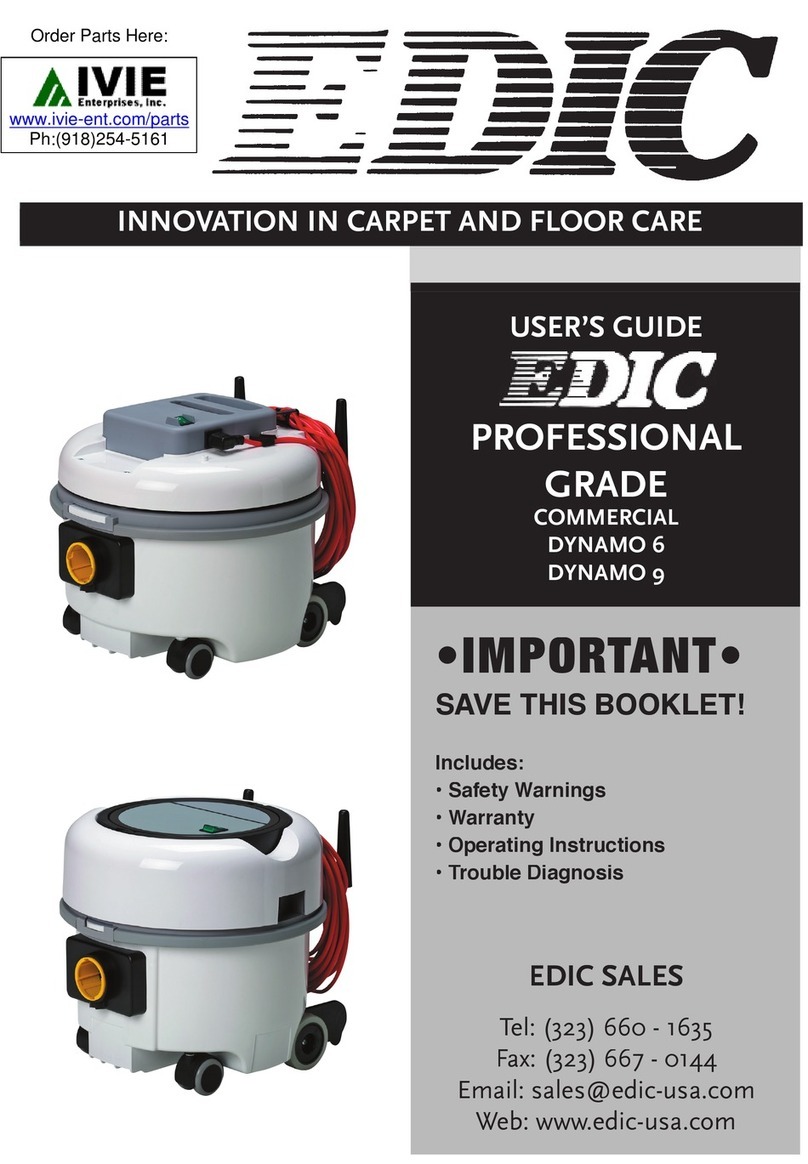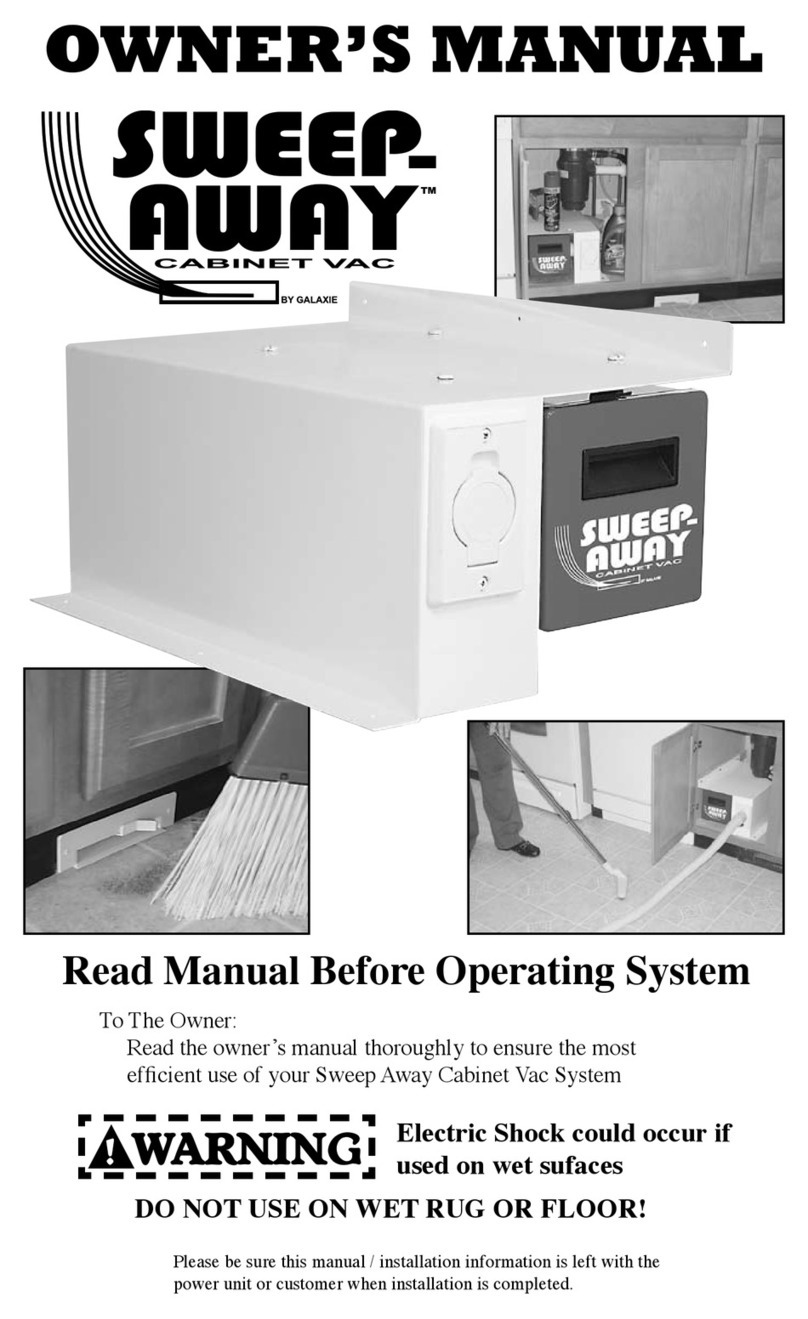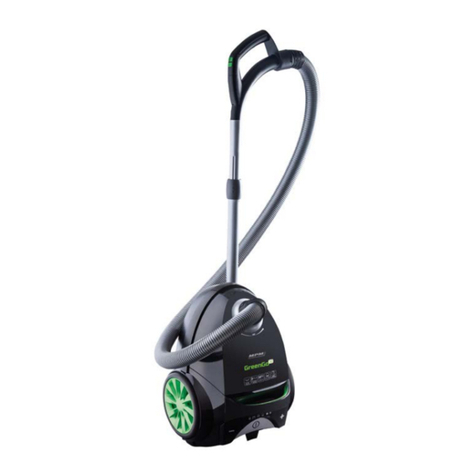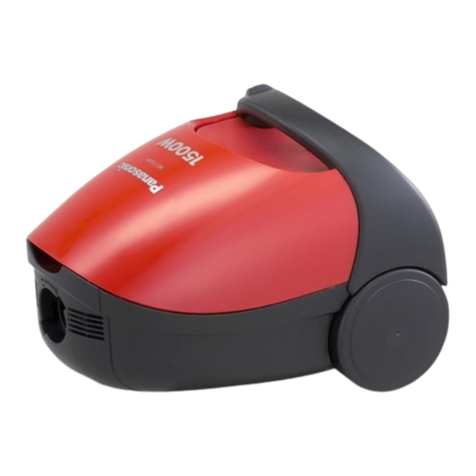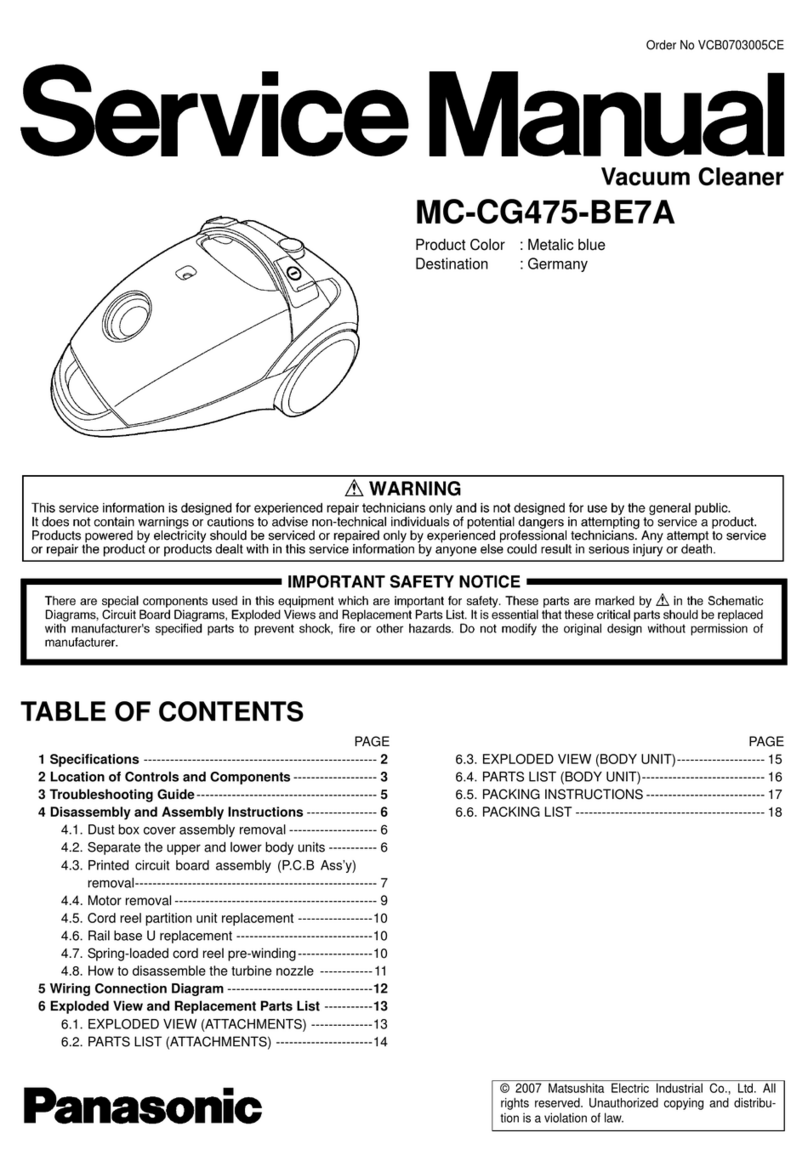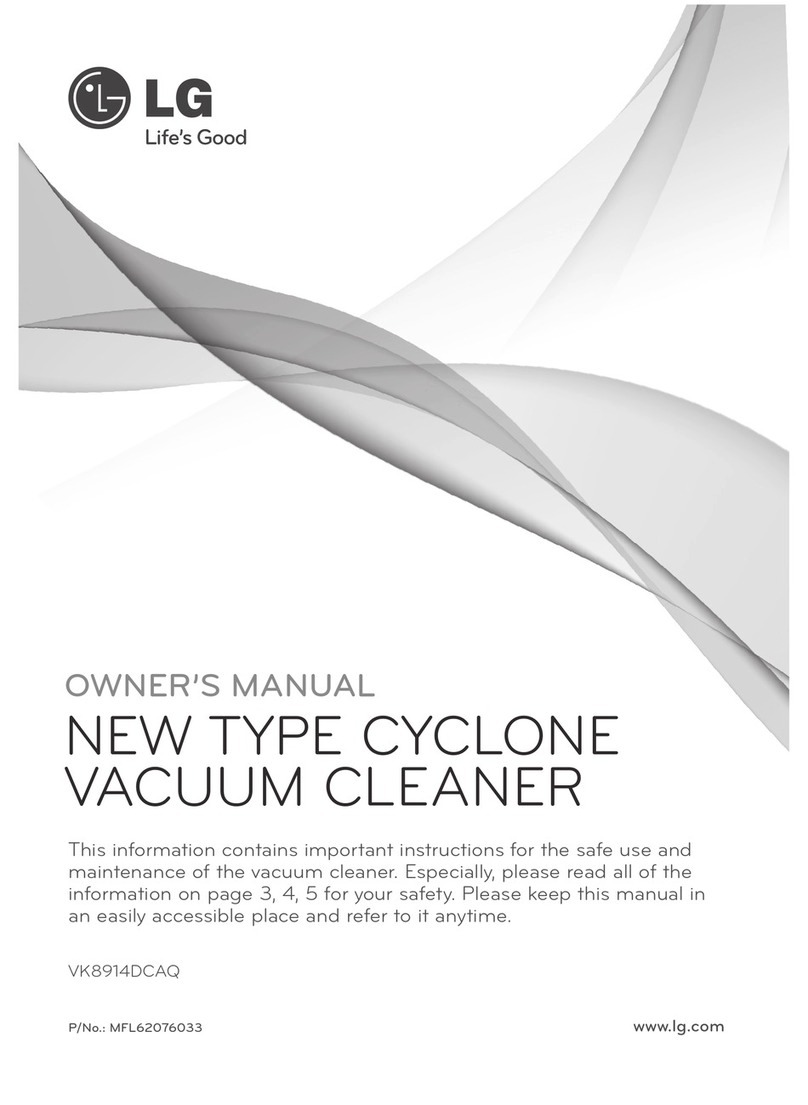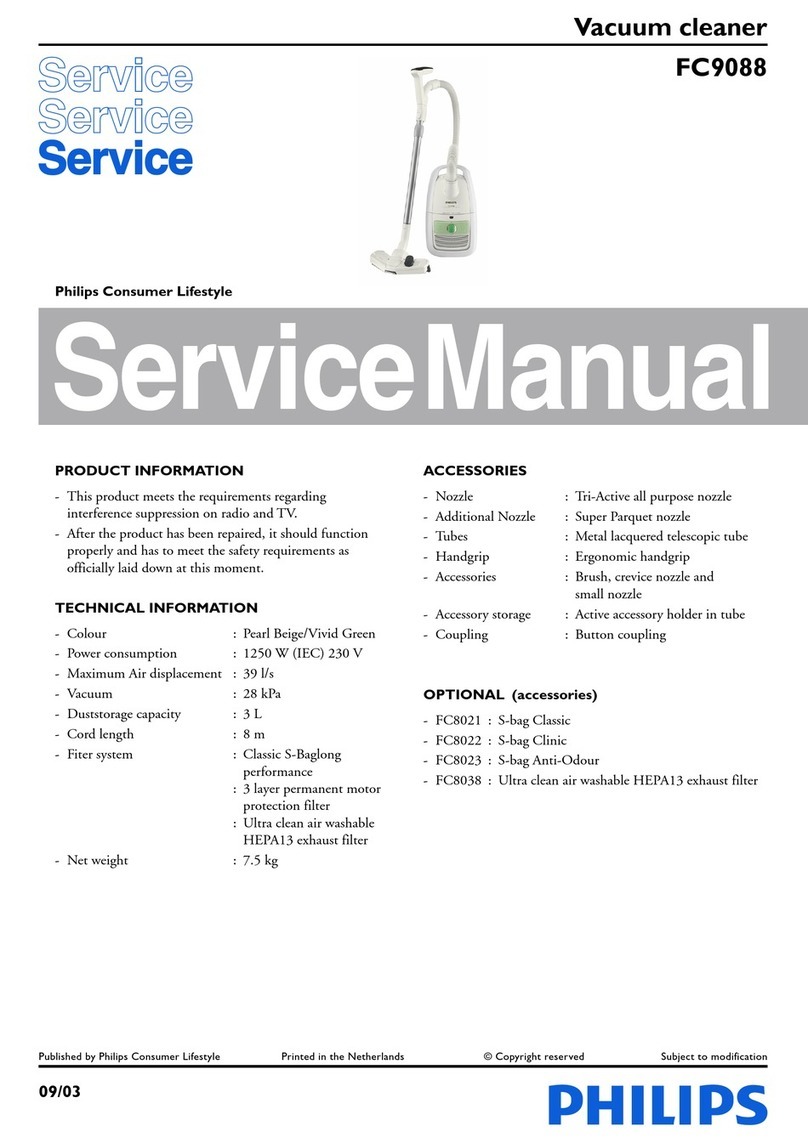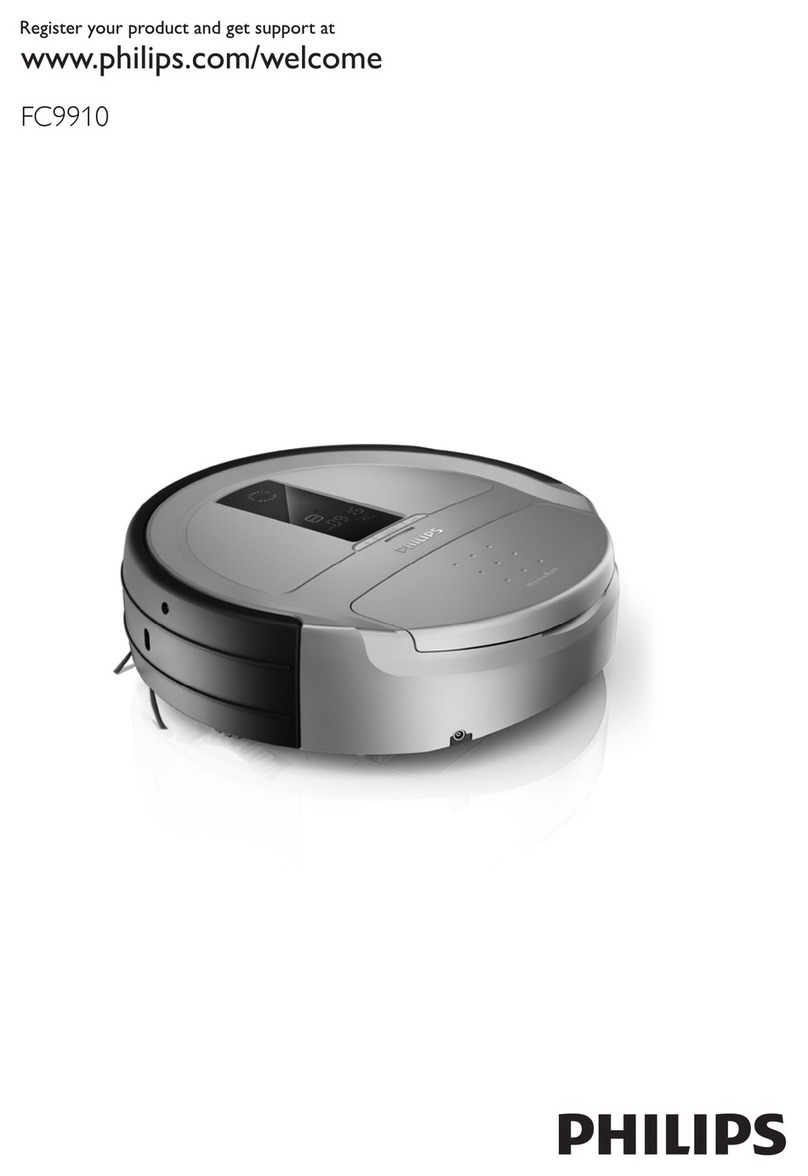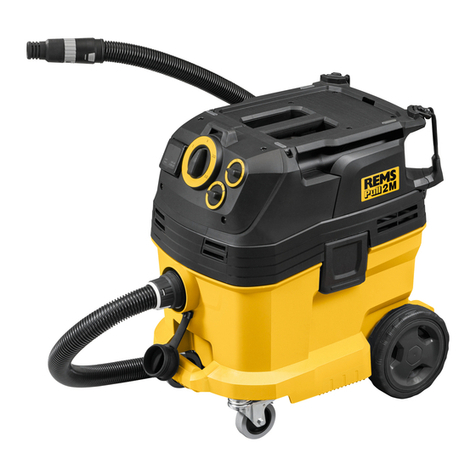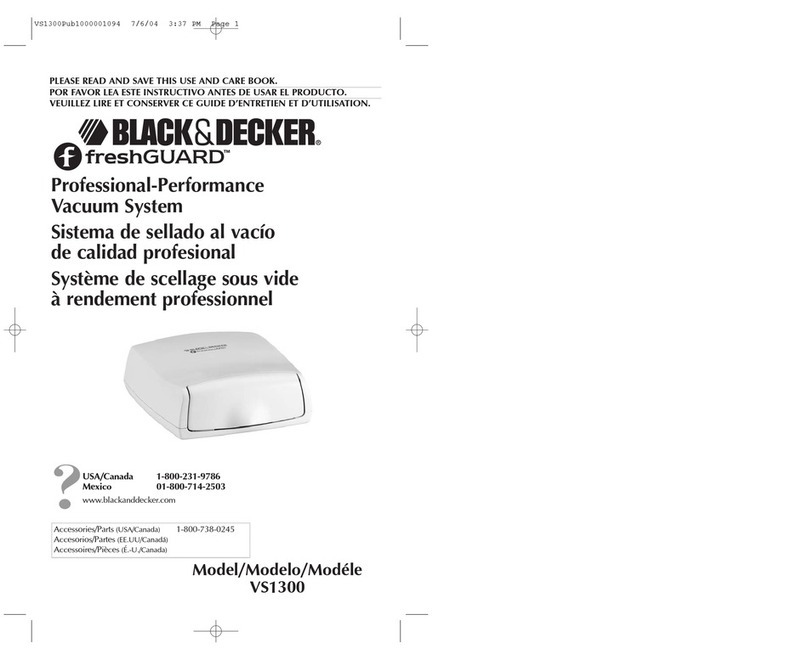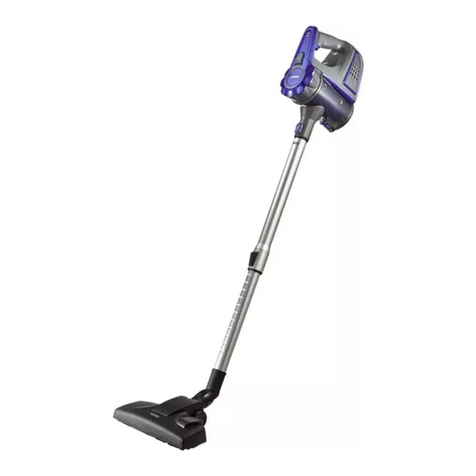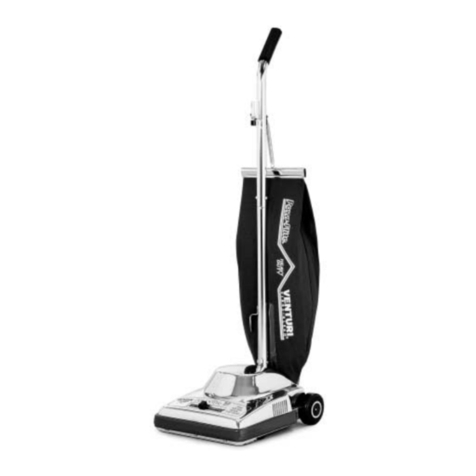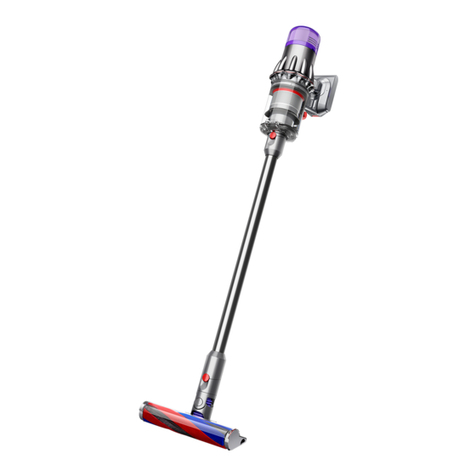Esta DUSTOMAT-21 User manual

OPERATING INSTRUCTIONS
The World of Extraction
DUSTOMAT-21 to -67
Mobile Dust Extractors
Dust Classification H

Your purchase of an ESTA machine has
been a good decision. The design of
our quality products complies with the
latest state of the art. ESTA products
have been devised to provide for clean
air at the workplaces at which they are
applied. This results in an even more
enhanced level of quality and longer
machine times and, particularly, healthier
working conditions. Should you have
any questions pertaining to suction tech-
nology issues, please feel free to contact
us at any time. Our experts will be gladly
at your disposal.
Your ESTA Absaugtechnik Team
The World of Extraction
www.esta.com
Welcome to the sphere of suction
technology

Operating Instructions
DUSTOMAT
-21 to -67 H
Item No. 09.302 (DUSTOMAT-21H)
Item No. 09.303 (DUSTOMAT-22H)
Item No. 09.304 (DUSTOMAT-23H)
Item No. 09.322 (DUSTOMAT-27H)
Item No. 09.305 (DUSTOMAT-41H)
Item No. 09.306 (DUSTOMAT-42H)
Item No. 09.307 (DUSTOMAT-43H)
Item No. 09.323 (DUSTOMAT-47H)
Item No. 09.308 (DUSTOMAT-61H)
Item No. 09.309 (DUSTOMAT-62H)
Item No. 09.310 (DUSTOMAT-63H)
Item No. 09.324 (DUSTOMAT-67H)
and variations
Do not use this device unless you have
read the user manual and understand it.
Translation of the original instructions
09302-08-00

2 DUSTOMAT 21-67 H 09302-52-00
Edition notice
Original operating instructions
Document no.: 09302-08-00
Publishing date: 07/03/2012
Type of device: DUSTOMAT -21 H to -67 H mobile dust extractors
Item no.: 09.302 // 09.303 // 09.304 // 09.322 // 09.305 // 09.306 // 09.307
09.323 // 09.308 // 09.309 // 09.310 // 09.324 and variants
Publisher
ESTA Apparatebau GmbH & Co. KG Tel.: +49 (0) 73 07 80 4 -0
Gotenstr. 2-6 Fax: +49 (0) 73 07 80 4 -500
Germany www.esta.com
Copyright notice (per DIN ISO 16016:2007-12)
Transfer or reproduction of this document, or the use or communication of its content, is
forbidden without explicit consent. Violators will be liable for damages. All rights to patent, utility
or design registration are reserved.
Warnings and safety instructions
Electrical current hazard
Note
Reference to ESTA customer service
Reference to legal regulations

09302-52-00 DUSTOMAT 21-67 H 3
Contents
Contents .....................................................................................................................................3
1.General safety notes ...........................................................................................................4
2.Preventing mechanical hazards .........................................................................................6
3.Preventing electrical hazards .............................................................................................6
4.Preventing dust hazards .....................................................................................................7
5.Intended use ........................................................................................................................8
6.Technical data and description ........................................................................................10
6.1 DUSTOMAT - 21 H to - 67 H............................................................................................10
6.2 Function description .........................................................................................................11
7.Delivery and commissioning ............................................................................................ 12
7.1 Delivery and transport ......................................................................................................12
7.2 Start-up.............................................................................................................................12
8.Maintenance and troubleshooting ................................................................................... 14
8.1 Maintenance instructions..................................................................................................14
8.2Inspection and maintenance intervals...........................................................................15
8.3 Troubleshooting................................................................................................................16
9.Monitoring the minimum airflow volume......................................................................... 18
10.Dedusting ...........................................................................................................................19
10.1 Manual cleaning: DUSTOMAT-21, -41, -61....................................................................19
10.2 Motorized cleaning: DUSTOMAT-22, -42, -62................................................................20
10.3 Pneumatic cleaning: DUSTOMAT-23, -43, -63...............................................................20
10.4 Jet cleaning: DUSTOMAT-27, -47, -67...........................................................................21
10.5 Filter replacement...........................................................................................................21
10.5.1 Replacing the pre-filter on a DUSTOMAT -21, -41, -61,..............................................22
10.5.2 Replacing the pre-filter on a DUSTOMAT -22, -42, -62,..............................................22
10.5.3 Replacing the pre-filter on a DUSTOMAT -23, -43, -63,..............................................23
10.5.4 Replacing the pre-filter on a DUSTOMAT -27, -47, -67,..............................................23
10.5.5 Replacing the main filter (backup filter cassette).........................................................24
11.Disposal..............................................................................................................................24
11.1 Disposing of collected dust materials .............................................................................24
11.2 Disposing of the dust extractor.......................................................................................25
12.Optional equipment ...........................................................................................................26
12.1 Start-up with potential-free contact.................................................................................26
12.2 Pre-separator .................................................................................................................27
13.Device diagram ..................................................................................................................28
14.EC Declaration of Conformity...........................................................................................29
Notes.........................................................................................................................................30
Notes.........................................................................................................................................31
Notes.........................................................................................................................................32

4 DUSTOMAT 21-67 H 09302-52-00
1. General safety notes
Before operation, all persons who are to use the dust extractor or perform
maintenance on it must be provided with information, instructions, and training in
using the device and on the substances for which it is to be used, including the
procedure for safe disposal of the collected material. Responsibilities must be
clearly established for the following:
Installation
Commissioning
Operation
Maintenance and repairs
The device must be used only by persons who have been instructed in its
handling and are explicitly authorised to use it.
Always keep the operating manual at the place where the suction device is being
used, so that it can be seen by personnel at all times.
No liquids, aggressive gases, easily flammable materials, or glowing particles
(such as hot embers) may be sucked in. For example, it is prohibited to use the
DUSTOMAT in painting operations. It is forbidden to vacuum processing machines
with active ignition sparks or hot embers (such as multi-blade saws).
The dust extractor is intended only for dry cleaning and must not be used or stored
outdoors or under wet conditions.
Installation and operation in dust explosive zones or gas explosive zones is
not permitted.
Only original ESTA replacement parts must be used; use of other products will
void the warranty.
During extraction, the volume flow returned from the dust extractor into the room
must be no more than 50% of incoming air. With free room ventilation, the
incoming airflow must equal the room volume every hour. This means that the rate
of air replacement must be once per hour.
Incoming air flow [m³/h] = room volume [m³] air replacement rate [1/h]
Example:
When the dust extractor is operating at the nominal airflow volume of 1,060 m³/h
the same volume of fresh air must therefore be fed in. This occurs with natural
ventilation if the volume of the work room is 1,060 m³ (e.g., 442 m² surface with a
2.4 m ceiling height).

09302-52-00 DUSTOMAT 21-67 H 5
Make sure that the power cable does not become damaged by being run over,
compressed, pulled, etc.
The power cable must be examined regularly for signs of damage or ageing.
The device must not be used if damage to the power cable is detected.
The power cable and plug must be replaced only by an appropriately trained
electrical specialist.
For the power supply and the device’s power cords, only original ESTA
replacement parts must be used. This guarantees that they are spray-proof
according to applicable standards and have the necessary mechanical strength.
The power cord must be plugged in only after the dust extractor has been
successfully set up at its place of use. For this a 16-amp CEE wall socket must be
in place.
Plugs and connectors complying with EN 61241-14 must be used for connecting
electrically driven industrial dust extractors and dust extractors. Coupling plugs
and connectors or adapters are not permitted.
After use, before moving the device to another site and before cleaning,
maintenance, or the replacement or removal of movable parts, the device must be
unplugged and any compressed air must be disconnected.
The DUSTOMAT is to be moved on a stable, even surface that can securely
support a weight of 350 kg.
To prevent dust release when transporting the device, the intake connection piece
must be closed with the sealing plug.
Only original ESTA conductive accessories may be used for operating the
device.
From its first use, the device contains toxic dust. Emptying and
maintenance processes, including removal of the dust collection container,
must be performed by expert personnel who are wearing appropriate
protective gear. The device must not be operated without the complete
filtration system!

6 DUSTOMAT 21-67 H 09302-52-00
According to work equipment user directives 2009/104/EC and
TRGS 553, safety devices for prevention or removal of hazards must be
regularly maintained and regularly inspected by an expert for safe, flawless
operation.
In all emergencies, the device must be disconnected from the power supply
immediately. Turn the device off with the emergency switch and pull the
plug. If there is a fire, the fire department is to be alerted immediately, and
the fire must be contained by appropriate means. A suitable extinguishing
agent must be kept near the device before start-up and during operation.
2. Preventing mechanical hazards
All movable machine parts driven by electric motors must be covered by fixed,
securely fastened protective covers that can be removed only with tools.
An exception to this is the brush cleaning inside the filter. If there is a block, the
safety mechanism (miniature fuse) must be tripped. Because this mechanism is
tripped by only a slight deviation below normal cleaning power, there is no danger
of injury.
Residual risk:
If a covering that can only be unfastened with a tool is removed, there is risk
of injury if the machine is running!
3. Preventing electrical hazards
All electrical parts must be covered by fixed, securely fastened protective covers
that can be removed only with tools. The device complies with Protection Class I
according to EN 60 335.
Residual risk:
If a covering that can only be unfastened with a tool is removed, the risk of
an electric shock cannot be ruled out!

09302-52-00 DUSTOMAT 21-67 H 7
4. Preventing dust hazards
Using a one-way dust collection bag with a closable opening guarantees low-dust
removal of the collected material.
The device is designed for use with dusts that are hazardous to health. When
working on the open device (for maintenance, cleaning, repairs), the operator must
take special protective measures, which include wearing special personal
protective gear. When the device is being operated, the complete filtration system –
consisting of the pre-filter, main filter and the filter for the bag intake – must always
be used. The main filter element may not be re-used once it has been removed
from the device. The following warning is shown on the device.
Open the device only when it has been turned off from the control panel, and when
it has been determined by a wait time of about 4 minutes that the automatic
dedusting process has been performed and that the dust inside the device has
settled in the dust collection container. Before opening, turn the device off at the
main switch and secure it against unintentional reactivation. Using a one-way dust
collection bag with a closable opening guarantees low-dust removal of the
collected material.
Residual risk:
When emptying the dust collection bag, it is possible to inhale dust.
Following the instructions in the “Disposal” section will minimize this hazard!

8 DUSTOMAT 21-67 H 09302-52-00
5. Intended use
The ESTA dust extractor has been manufactured according to the state of the art
and in compliance with safety regulations. It is suitable for commercial use, such
as in industrial firms and workshops.
The DUSTOMAT H-type devices are not only suitable for extracting dry, toxic
dusts with exposure limit values smaller than
0.1 mg/m³, but also for extracting (and separating) toxic dusts with occupational
exposure limit values (OELVs) including carcinogenic dusts. Since carcinogenic
dusts may also be extracted using dust-class-H devices, here – especially in
relation to air recirculation – the provisions of
TRGS 560 must apply.
They are fitted with a dust-class-"M" pre-filter and a dust-class-"H" main filter
(backup filter cassette) (high risk) and are tested based on Annex AA of standard
EN 60335-2-69.
Conductive extraction equipment (e.g., extraction hoods on machines) and
conductive parts of processing machines (e.g. devices in protection class II) that
are not earthed (grounded) through the dust extractor must be earthed in some
other way to prevent electrostatic charges.
The maximum allowable extraction port diameter for devices in dust class H is 140
mm.
It is forbidden to connect a dust source with a suction connection whose
diameter is greater than that of the dust extractor.
When connecting a suction hose, make sure to use only electrically
conductive hoses and that the electrical connection between the hose and
the port is perfect. If a so-called “spiral hose” is used, the metal spirals must
be stripped and pressed to the bare wall of the extraction port with a pipe
clamp after the hose is attached. Only metal should be used as tube
material.
The device must not be used or stored outdoors or under wet conditions.
The dust extractor’s discharge openings must not be closed or covered. Otherwise,
the device will get impermissibly hot and will no longer work.

09302-52-00 DUSTOMAT 21-67 H 9
Only plugs and connectors complying with EN 61241-14 must be used for
connecting electrically driven industrial vacuums and dust extractors.
Extension cords, coupling devices and adapters are not permitted.
Installation and operation in dust explosive zones or gas explosive zones is not
permitted.
Other applications are considered unintended use. ESTA is not liable for damages
due to unintended use!
ESTA sets up the dust extractor according to the operator’s information.
The device is suitable for extracting dust-class-H dusts and other flammable
dusts of dust explosion class St 1 (Kst value ≤200 bar m/s).
The device is not suitable for extraction of explosive or equivalent materials
in the sense of Section 1 of the explosives act, of dusts or dust explosion
classes St 2 and St 3, of dusts with low minimum ignition energy and of
explosive gases or gas/air mixtures, of flammable liquids or of mixtures of
flammable dusts with liquids.
When operating the device with a frequency converter, the operator must
make sure that the minimum airflow volume is maintained in every
operational state of the extraction process and that no build-up can thereby
accumulate.

10 DUSTOMAT 21-67 H 09302-52-00
6. Technical data and description
6.1 DUSTOMAT - 21 H to - 67 H
Type
(see model plate) 21/22/23/27 41/42/43/47 61/62/63/67
Max. airflow volume [m³/h] 1,060 1,330 1,500
Connection diameter [mm] 125 140 140
Max. vacuum [Pa] 3,550 3,800 4,350
Nominal volume flow [m³/h] 884 1,108 1,108
Minimum volume flow [m³/h] 795 997 997
Connection voltage [V] 400
Nominal frequency [Hz] 50
Drive output [kW] 2.2 3
Rated current [A] 4.5 6.3 6.3
Circuit breaker (A) 16
Filter area, dust class “M” [m²] 9.6
Filter area, dust class “H” [m²] 18
Dust collection container [litres] 200
Environmental conditions [°C] 525
Max. air humidity [%] 60
Dimensions [mm] 1,830 x 782 x 2,040
Weight [kg] 240 260 265
Max. sound pressure level Lpa* dB(A) 74 75 78
Production year See model plate
* = as per DIN EN ISO 3744, measurement margin of error approx. 4 dB(A)
We reserve the right to make technical changes.

09302-52-00 DUSTOMAT 21-67 H 11
6.2 Function description
Depending on the model, the DUSTOMAT is driven by a 2.2 kW or 3.0 kW three-
phase motor that drives a radial fan.
The main switch supplies or cuts off the necessary power to the device, and the
device is turned on and off with the red-green double push button.
The vacuum created by the fan draws air through the suction hose connected to
the intake port. A permanent filter set up within the filter housing separates the
dust that is in the exhausted air.
The purified air is guided back into the room through the exhaust vents.
The DUSTOMAT is equipped with a vacuum monitor as a control device for
overseeing minimum airflow volume. This monitoring device measures the
vacuum in the filter. With increased dust soiling of the filter, the flow resistance
increases along with the vacuum behind the filter. If the value set on the vacuum
monitor is reached, an acoustic signal sounds. This means that the minimum
airflow volume has fallen to the limit and that the filter must be cleaned.
Depending on the model, filter cleaning is handled in various manners. The
cleaning clears the filter of dust and refurbishes it. The dust collection container
underneath the filter catches the dust that is cleared.
For easier removal of the collected dust material, the upper part can be tipped
backwards and the dust collection container removed from the device complete
with its contents.
Category H devices have a main filter in addition to the filter described above. It is
this filter that allows the device to comply with dust class "H". It cannot be
cleaned, so when necessary it must be replaced.

12 DUSTOMAT 21-67 H 09302-52-00
7. Delivery and commissioning
7.1 Delivery and transport
At delivery, the DUSTOMAT is fastened to a pallet. After the protective cover and
the bottom fasteners have been removed, the device can be picked up with a
forklift. Do not use a crane!
Upon delivery please inspect the device for transportation damage. Damage
determined must be reported and documented immediately.
ESTA customer service: +49 (0) 7307 804 - 0
When moving the device, make sure the ground can support it and be driven
over.
7.2 Start-up
Only persons authorised under “General safety instructions” may turn the
device on.
Before setting up the cable connection between the device and the power
grid, check to make sure the operating voltage shown on the model plate is
the same as that of the grid.
Before the device is first used, a function check must be performed.
For start-up, the red-yellow power cut-off switch must be turned to the "I" position.
(This switch also serves as an emergency shut-off and can be secured with a
padlock against unintentional activation.)
The device is turned on and off with the double push button.
Power cut-off
switch ON switch
Direction of
rotation monitor
OFF switch

09302-52-00 DUSTOMAT 21-67 H 13
Optionally, the device can be equipped with an additional
rotary switch and a plug connection device for potential-
free contact. During manual operation, this switch must
be set to the “HAND” position. During control through a
processing machine, the switch must be at “AUTO”.
The fan’s direction of rotation must be checked!
After turning on the device, make sure that the fan rotor’s direction of rotation is
correct. Meanwhile, also look at the red light on the double push button. If this
lights after the main switch is turned on, the direction of rotation is wrong, and the
power supply’s polarity must be reversed. For this purpose, the CEE plug is
equipped with a phase inverter.
The polarity of the power feed must be changed only by an electrical
specialist. For this purpose, the CEE plug is equipped with a phase inverter.
Using a screwdriver to turn the pole pin built into the insulated part of the
plug changes the fan rotor’s direction of rotation.
When the direction of rotation is wrong, the device becomes impermissibly
hot, the airflow volume gets weaker, and the device’s performance suffers.
This can also damage the device.
Once a functional inspection has been completed, the connection can be made to
the processing apparatus that is to be extracted.
For this, the device must be turned back off, unplugged from the power grid, and
set on an even surface as close as possible to the workplace. Lock the device’s
wheels.
The dust extractor’s intake port has an interior diameter of 125 mm or 140 mm,
depending on the model.
At the port, the suitable electrically conductive ESTA suction hose is inserted and
secured with the locking bolt. This suction hose comes with a plug connection
attached.
Connection is made to a processing machine that has a smaller port diameter by
using a reduction adaptor that fits the extraction hose and is chosen to fit the port
diameter of the machine creating the dust. Here also, pay attention to the
electrical conductivity between the connections.
Now the device can be reconnected to the power grid and also, for devices
with pneumatic filter cleaning, to the necessary compressed air supply.
(DUSTOMAT -23,-27,-43,-47,-63,-67)
Rotary switch

14 DUSTOMAT 21-67 H 09302-52-00
The quarter-inch compressed air connection nozzle is on
the upper filter housing.
The compressed air supply line (4-6 bar, oil- and water-free)
can be connected to the device with a model DN 7.2 ¼-inch
coupling.
After connecting the suction hose to the processing machine, first set the
dust extractor in motion, and then the processing machine. When switching
off, follow the same procedure in reverse.
During operation, the dust extractor’s location should not be changed.
When the device is turned off, the neutral line is not disengaged. The device
is therefore intended only for use in TN networks.
8. Maintenance and troubleshooting
8.1 Maintenance instructions
For maintenance by qualified personnel, the device must be opened, cleaned and
inspected at the given locations, as far as this is feasible, without any hazard
being posed to maintenance personnel or to other persons. Proper precautions
must be taken before cleaning and removal of wearing parts. This includes locally
filtered forced-air ventilation in the area in which the device is being maintained
and proper personal protective gear.
During maintenance or repair work, all soiled objects that can no longer be
adequately cleaned must be disposed of. Such objects must be discarded in an
impermeable bag in compliance with applicable regulations for disposal of such
refuse.
If the device is not needed in its location of use for a long time, it must be stored in
a dry room. The temperature should not be below 5°C or above 25 °C.
Before the device is placed into storage, it is recommended that it be cleaned with
a disposable damp cloth, that the filter be cleaned, and that the dust container be
emptied.
The device must never be cleaned with flowing water.

09302-52-00 DUSTOMAT 21-67 H 15
The operator is obligated to have maintenance performed once per year.
During maintenance, the device is to be tested by a trained expert for
correct operation. A log is to be kept of the main annual inspection in the
maintenance book included. It must document the date of inspection,
deficiencies determined and the name of the inspector. The date of the next
inspection can be read from the test plate installed on the device.
8.2 Inspection and maintenance intervals
Regular maintenance consists of 3 intervals:
1. Daily inspection includes:
By cyclone filter users
Visual inspection
for damage to the device or its parts,
for mechanical damage to the power cable,
for a full dust collection container (regulations require that the container be
emptied if it is more than 2/3 full)
2. Monthly inspection includes:
By expert maintenance personnel
Visual and functional inspection,
for filter leaks (dust trails or deposits on the air outlets)
whether the minimum airflow volume inspection function (acoustic signal) is
assured. During inspection, the device’s air intake must be closed. If the
acoustic signal sounds, the equipment is in order.
3. The main annual inspection includes:
The last test by ESTA is documented on the device.
In collaboration with the ESTA maintenance service
Flow volume measurement
Vacuum measurement
Current consumption measurement
Visual check of filters
Seal inspection
After maintenance, the device receives a new test plate to document that
maintenance has been performed.
This inspection must be done once per year.

16 DUSTOMAT 21-67 H 09302-52-00
The maintenance work must be recorded in writing in the maintenance book
provided. This must make clear the equipment inspected and, if necessary,
the deficiencies found, along with the name of the inspector and the date of
the inspection.
If there is a malfunction, the dust extractor must be switched off
immediately and the responsible maintenance service notified.
According to work equipment user directives 2009/104/EC and
TRGS 553, safety devices for prevention or removal of hazards must be
regularly maintained and regularly inspected by an expert for safe, flawless
operation.
Maintenance must be performed according to accident prevention
regulations. The device must be disconnected from the electrical power and
from the compressed air network. Even when the compressed air supply is
turned off, the compressed air tank is still under pressure! (model-
dependent)
Get the most from ESTA’s maintenance service!
A maintenance contract ensures long life and top-notch operation for your
dust extractor.
We’ll make you a great offer — simply give us a call:
ESTA maintenance service: +49 (0) 7307 804 - 0
ESTA replacement part service: +49 (0) 7307 804 - 0
8.3 Troubleshooting
Always use the following checklists if a malfunction is evident. Call the ESTA
maintenance service right away if there is a malfunction that is not discussed in
this list. Do not perform any repairs on the device yourself if they are not explicitly
specified.

09302-52-00 DUSTOMAT 21-67 H 17
Failure Possible cause Possible solution
Motor stalls / motor won’t
restart Motor protection
triggered by frequently
turning the device on and
off
On devices with
potential-free start-up,
the motor protection
must be reset manually.
(The motor protection is
inside the switch box.)
The device has shut off
during cleaning.
The electromechanical
device for up and down
movement is dirty, which
has triggered the motor
protection switch.
Clean the frame (for
disassembly, see the
“Filter replacement”
section).
Suction performance
diminishes /
or no suction
Filter clogged
Suction hose clogged
Dedust filter
In a vacuumed area,
hold the hose vertically
and bang it out with a
rubber mallet.
Warning signal for low
suction volume persists
despite filter dedusting.
Fine dust is sucked right
back to the filter.
Pressure controller set
too weak
Dust collection container
too full
Filter pores clogged in
main filter
Dedust several times
with device at rest and
let the dust settle (1 min.)
Change the pressure
controller after consulting
with ESTA
Replace dust bag
Replace filter
If dust escapes or clouds up from the air outlets, if smoke develops or the
fan runs loudly, the device must be disconnected from the power
immediately!
The person doing the work should always wear a respirator mask (filter
mask with particle filter, filter class P3) and gloves.
Before opening the switch box, make sure to turn the main switch to the “0”
position and pull the electrical plug! Work in the switch box must be
performed only by an electrical expert or an appropriately trained person.

18 DUSTOMAT 21-67 H 09302-52-00
9.Monitoring the minimum airflow volume
With the dust extractor, the processing machines can be dedusted with exhaust
ports of various diameters. In so doing, check that the exhausted airflow volume
does not drop below the lower limit. The minimum airflow volume depends on the
size of the intake connection piece of the machine creating the dust. The dust
extractor’s monitoring equipment (pressure switch with connected acoustic signal)
must be adjusted to this minimum airflow volume.
This device measures the vacuum in the filter. With increased dust soiling of the
filter, the flow resistance increases along with the vacuum behind the filter. If the
value set on the vacuum monitor is reached, an acoustic signal sounds. This
means that the filter must be cleaned.
Depending on the device’s equipment, do this manually after switching off, or
automatically during operation (DUSTOMAT -27,-47,-67).
If the pressure controller’s preset value is too weak for operational use
conditions (long extraction distances and small tube diameters), it means that a
short time after cleaning, the acoustic signal will be triggered again. This can be
adjusted upon consultation with ESTA
maintenance services.
The pressure switch must be adjusted only by an
appropriately trained person. The adjustment is
made with a size 6 Allen wrench. After the
pressure switch has been set, the device is ready
for operation again.
preset pressure controller
This manual suits for next models
35
Table of contents
Other Esta Vacuum Cleaner manuals

Esta
Esta DUSTOVAC 5.5 FM User manual

Esta
Esta DDE 1500 User manual
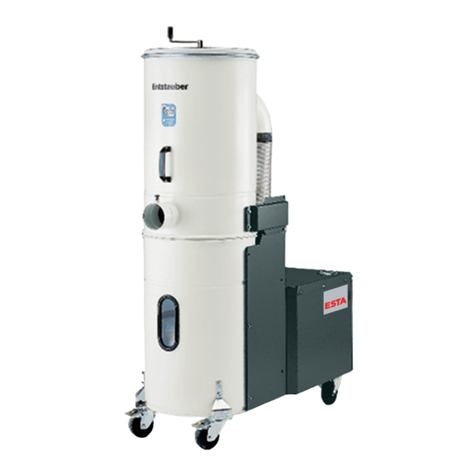
Esta
Esta DUSTOMAT-10 User manual

Esta
Esta WHISPERSOG User manual
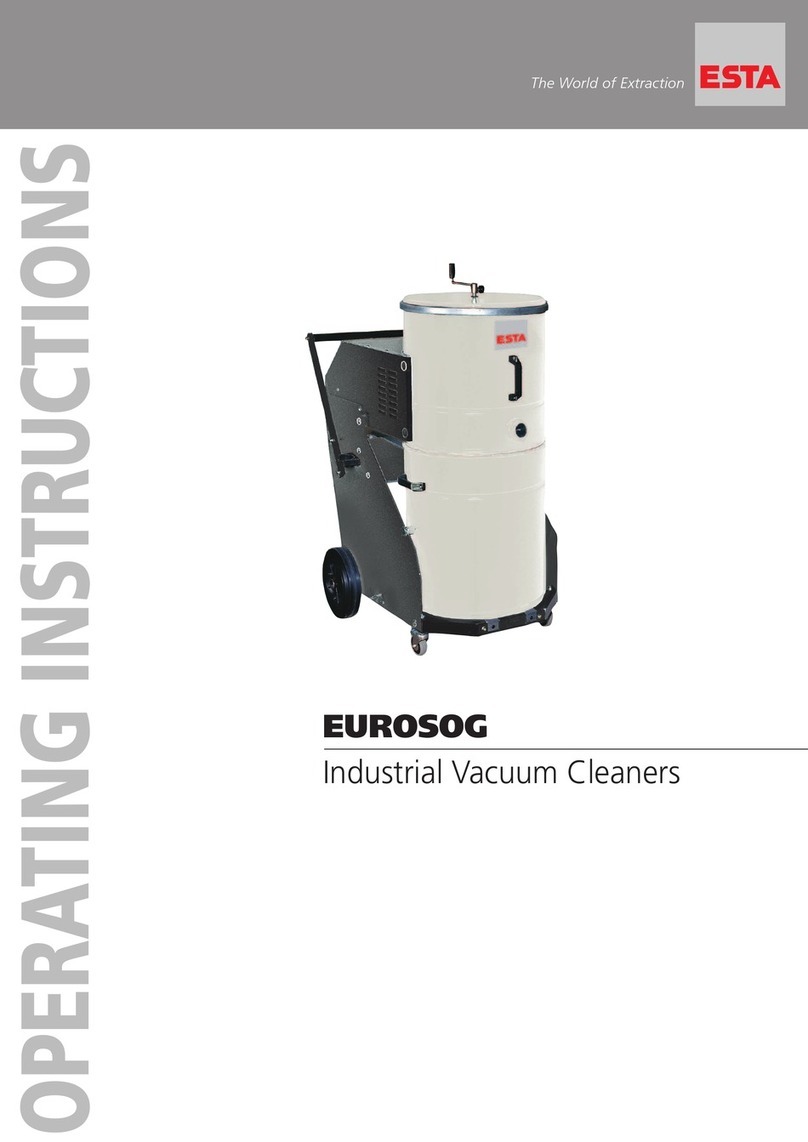
Esta
Esta EUROSOG-W/N User manual
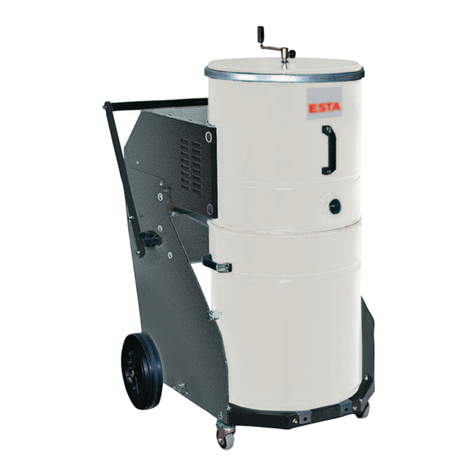
Esta
Esta EUROSOG - ATEX User manual
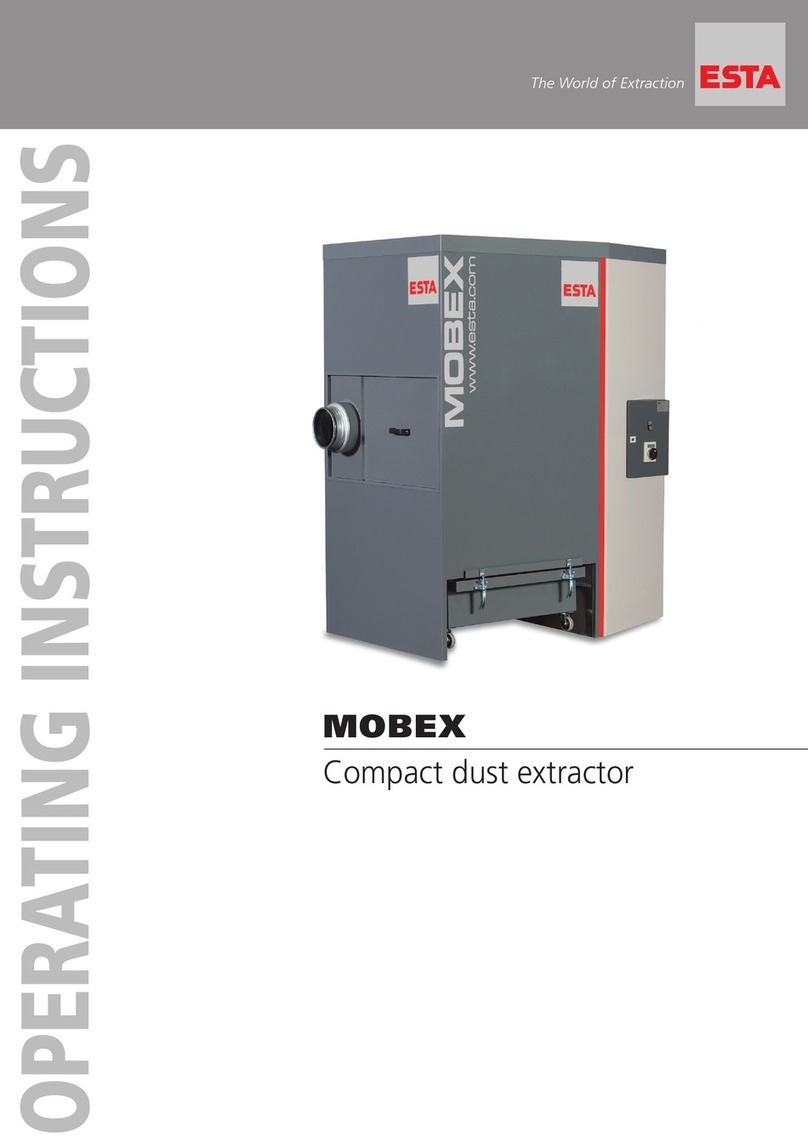
Esta
Esta MOBEX P-24 User manual
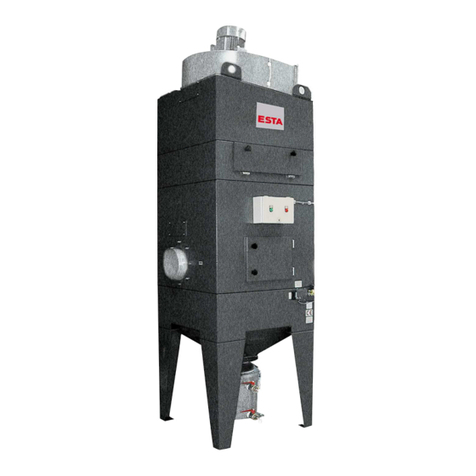
Esta
Esta NA-K B/VA User manual

Esta
Esta NA-K User manual
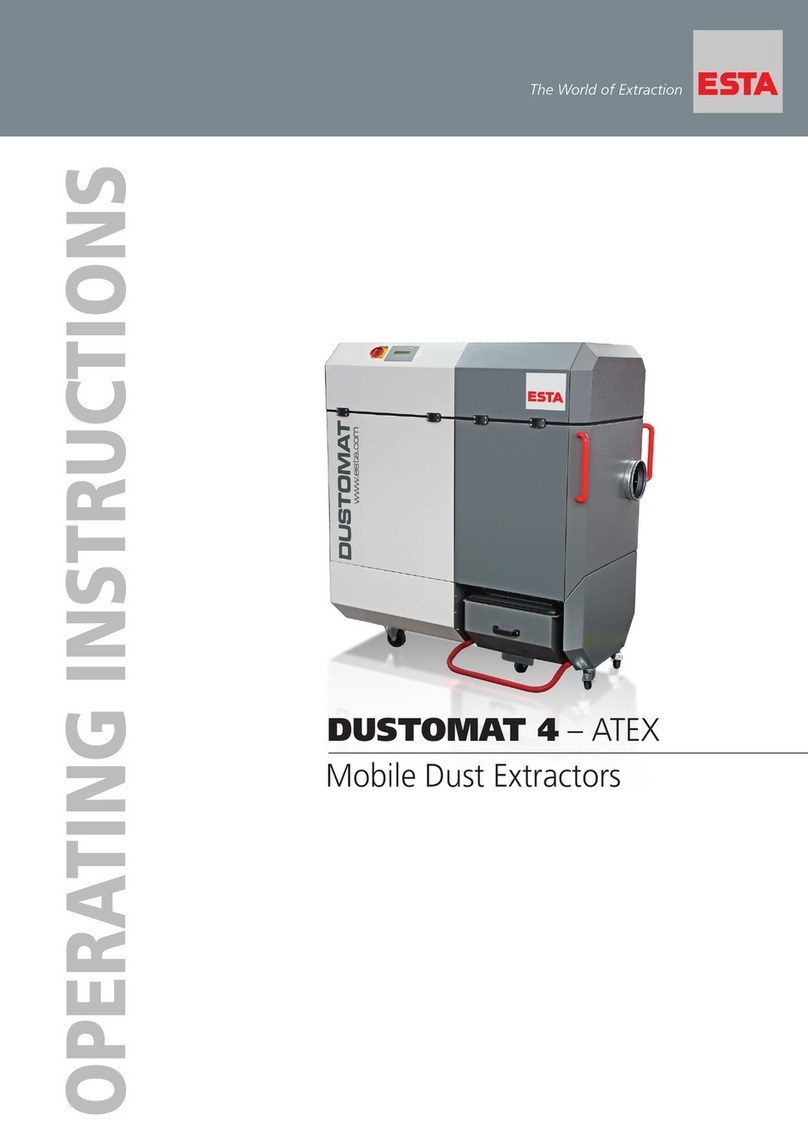
Esta
Esta DUSTOMAT 4 ATEX User manual


